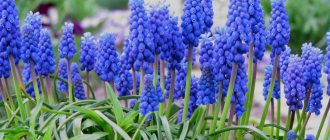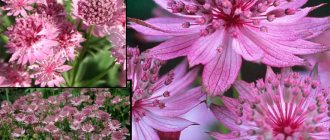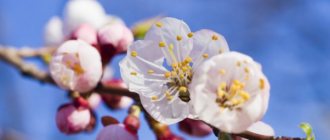- November 14, 2018
- Plant care
- Parfenyuk Oksanka
Phacelia is a herbaceous annual plant, which, however, is unpretentious to growing conditions. It is valued not only as a rather interesting decoration for homestead plots: phacelia is used as an effective honey plant that has a long flowering time. In addition, the crop has many useful properties that significantly improve and enrich the surrounding soil. Whether the phacelia plant, the photo of which is attached, is a perennial or annual plant will be discussed later in the article.
What kind of flower is this
The phacelia plant, the photo and description of which are posted in the article, is widely used by modern landscape designers, farmers, beekeepers and flower growers. Its height is 50 -100 cm. The strong stem is located straight, with many lateral shoots, resembling a small bush in appearance. The taproot rhizome grows to a depth of about 25 cm. The shoots are usually covered with pile, have ribbed skin and a bright green color.
Leaves of an ashen and green hue usually germinate oppositely or alternately, and can also be located on shortened petioles. During the growth of the phacelia, the leaf blade takes on a pinnate, dissected or lobed appearance; its edges can be solid or serrated; the relief of the veins can be clearly seen on it.
Growing and care
Phacelia is propagated by seeds through direct sowing in open ground. Young shoots are very resistant and can withstand temperatures as low as -9°C.
Therefore, it is advisable to sow in the fall, so that the crop itself chooses the time when to sprout.
This happens very early: there is still snow on the street, and friendly shoots of phacelia are already visible in the thawed areas. In the spring, phacelia can be sown as early as March - April, directly in the snow, if the soil for sowing has been prepared in the fall. And the last planting occurs after harvesting from the garden - preferably before the beginning of August.
Before frost, the phacelia will have time to grow well, after which the green mass is either left in the garden bed during the winter, or mowed and the soil is covered.
Phacelia is not demanding on living conditions and in any case will delight you with foliage and flowers, but if all the necessary conditions are created for it, then there will be much more green mass, and bright fragrant flowers too.
It should be planted in open areas, well lit by the sun and blown by the wind. Sow immediately in a permanent place.
The seedling method is not used, because phacelia has a negative attitude towards transplantation.
To prevent phacelia plantings from becoming too thick, it is recommended to mix small seeds with sand before sowing and sow the plots at the rate of 100 grams of seeds per 60-70 m².
Before sowing, the soil need not be further processed by plowing or digging, but rather sown directly on top. After sowing, the area is rolled with a roller or the seeds are pressed in another way. The main condition is that the soil is not virgin soil, otherwise the seeds will not break through the fused roots of the vegetation.
Sowing
If you plan to sow a small area of your garden, you can use the furrow sowing method.
Sowing occurs in moist soil, or, if the soil is dry, the plantings are watered artificially. After this, within one to two weeks, the first shoots appear. For small sowing areas, the plantings are thinned out with the appearance of the third true leaf, leaving a distance between bushes of about 10 centimeters.
Phacelia easily adapts to environmental conditions and requires minimal care. It tolerates drought and requires watering only if the dry period is extremely prolonged and the soil surface begins to crack.
Weeding
Until the phacelia has reached full strength and gained green mass, the plantings need to be thinned out to remove unwanted weeds, and the row spacing should be loosened.
These procedures are applied only during the first month of development, after which the phacelia will be able to take care of itself.
If you want to see lush bushes and bright flowers, then it would be useful to apply universal mineral fertilizers.
Mowing
When a crop is grown for livestock feed, there is no point in delaying mowing. The best time to mow is when the buds are setting. If the flowers have already bloomed, the stems and green mass will be less nutritious and rich in beneficial microelements, since everything will go into the flowers.
Collecting seeds
When to collect seeds?
The seeds are collected after the flowers have withered and the seed pods have become visually brown.- Seed pods ripen from bottom to top, so give preference to the bottom ones.
- It is also not worth waiting for all the flowers to wither, because when fully ripe, the seed pods crack and the plant reproduces by self-seeding.
Use in the garden
Using cascade sowing, you can achieve continuous flowering of phacelia until frost - this will add decorativeness to the garden and attract pollinating insects to your trees. And if you keep an apiary, it will give you tasty and healthy honey.
Decorative varieties of phacelia can be used to diversify flower beds, plant tree trunks, along borders, between garden crops, in rockeries and on an alpine hill. It is often used as an hanging plant, planted in flowerpots, on balconies and verandas.
Varieties of phacelia
The genus Phacelia, according to some sources, includes 55-80 species of this plant. In most cases, in our country, twisted, bell-shaped and tansy phacelia are grown. They will be discussed in more detail below:
- Phacelia tansy has a height of about a meter. This is an annual herb that forms a fairly large bush, since up to 20 woolly and fibrous shoots can extend from the main shoot. Around May, pale blue flowers bloom above the leaves, which acquire an oval shape and a jagged edge, collected in a one-sided spike-shaped inflorescence and shaped like a curl. Flowering is accompanied by a sweet aroma of honey.
- Phacelia twisted is distinguished by shoots no more than 50 cm high, which are covered with leaves of green or lighter color with a small pile and a jagged edge. During the period from June to September, very beautiful curls develop on the plants, consisting of bells about 5 mm in size.
- Phacelia bell-shaped has the appearance of erect stems with branches that are about 25 cm high. These are rather fragile but fleshy plants, the surface of which is covered with reddish and slightly fleecy skin. The ovoid-shaped leaves grow alternately and have uneven teeth along the edges. They grow up to 6 cm long and are painted a pleasant green color.
Purple or bluish flowers, which bloom in mid-summer, reach a size of about 3 cm. Large anthers and dark stamens emerge from the white funnel. The inflorescences are collected in curls located in racemes.
Growing phacelia as green manure
What time to sow
Phacelia is very popular among gardeners and gardeners who use it as green manure. The timing of sowing depends on what you want to achieve:
- Phacelia seeds can be sown immediately after the snow cover melts. The shoots that appear after half a month will actively increase green mass. If you leave the grass on the surface of the soil after mowing, you will get excellent mulch, and if you embed it shallowly into the soil, you will get good humus.
- If this plant is used as a honey plant, then it is sown between rows of other crops throughout the season. After wilting, the bushes are mowed, and then they can be used as mulch or fertilizer. If necessary, phacelia is re-sown in the vacated areas.
- If sowing is carried out after harvesting from the last summer weeks until the second half of autumn, then in this case such green manure will contribute to the healing and restoration of the soil, and it will also saturate it with nutrients and improve its composition. After mowing, phacelia can be left on the soil surface as mulch, in which case it can save the root system of perennials from freezing, while the soil will not be subject to erosion, and beneficial substances will not be washed out of it by rain in the fall.
- Winter sowing is also used. As a result, seedlings appear at the beginning of the spring period, they are mowed shortly before the main early crop is planted. In this case, the seeds must be sown very thickly, since after a frosty winter their germination rate suffers.
Sowing rules
There is no need to stratify the seeds of such a plant before sowing, since they have a fairly high germination rate. The soil on the site is loosened using a rake, and then seed material is scattered over its surface. The seeds are dark in color and therefore cannot be seen on the soil. Therefore, for ease of sowing, it is recommended to combine them with dry sand.
When sowing such green manure between rows of other crops, make a furrow with a depth of 20 to 30 mm, after which it is watered with a small amount of water and phacelia is sown in it. After which the groove must be sealed. If sowing was not done on a hot, dry day, then the crops do not need additional watering.
We sow phacelia
Phacelia flowering
The flowering process of this plant begins in late spring and continues, fortunately for gardeners, until late autumn. It is noteworthy that the flowers open only for a maximum of 2 days. Small buds are included in bunches of 50-100 pieces at the end of the stem. The plant has short peduncles, which can also “sit” on peduncles. The corollas of phacelia have the appearance of a bell, and they are colored, as mentioned above, usually purple or blue. Thin and long stamens with petals that have grown together look out from the central part of the flower.
The phacelia flower (see photo in the article) is pollinated by insects, after which the seed pods begin to ripen with a large amount of small seeds. So, in just 1 gram of sowing material there are about 2,000 seeds.
The flowering of the honey plant will depend on the weather: if it is cloudy and rainy, and also if there is a sharp drop in temperature, this will significantly reduce the release of nectar. Thanks to this characteristic, phacelia plantations located in the south have greater productivity than plants growing in the north.
Phacelia care
Phacelia is considered a tenacious and picky crop. It is characterized by resistance to drought; watering will only be needed in the event of a prolonged lack of precipitation - if the soil surface cracks. In the initial 2-3 weeks of seedling growth, weeding and loosening of the soil will be required. Then this procedure will no longer be required.
To improve flowering and rapid growth, it is recommended to fertilize the crop twice a season using universal mineral complexes. The buds open a month after sowing.
Seeds begin to be collected after half of the achenes have turned brown. The main thing is not to miss this moment, since the ripened achenes open naturally.
Features of reproduction
Cultivation is carried out immediately in open soil. Young seedlings can withstand sub-zero temperatures (not lower than -9°C). You can sow the plant for the winter; this is done in November (but before the onset of frost). In spring, sowing is allowed from mid-March until the second half of April.
Phacelia can be planted anywhere on your site, the plant takes root well, the main thing is to water it in a timely manner.
In July you can sow the plant a second time. Since the seeds are small, they are used to make a mass based on sand and sawdust. 100 g of seed is enough for a 60-80 m² plot. The distance between seedlings is 4-7 cm.
Plant propagation
The named plant reproduces through seeds. Planting is done in the spring. All seeds should be carefully covered with soil, as they germinate best in the dark. The first seedlings hatch approximately 7-10 days after sowing. After noticeable growth of the seedlings, they must be thinned out, leaving a distance of 10-15 cm between them.
Pests and diseases
Phacelia is attractive not only to bees, but also to predatory insects, whose larvae destroy garden pests:
nematode,- leaf roller,
- locusts and
- codling moth.
Despite the fact that phacelia does not have many enemies, but if a disease occurs or a pest attacks, it is considered inappropriate to treat phacelia; it is simply mowed down and destroyed.
Features of breeding phacelia
Due to the fairly wide sowing row, plants need regular row-spacing treatment and weed removal. Many gardeners prefer to treat seeds with special herbicides before sowing. But, in fact, this does more harm to the future plant than it benefits. After flowering is over, the plants must be mowed and chopped, and then buried not very deep in the ground.
Phacelia is planted in early spring, when the snow has just melted, and until autumn. But the most fertile time for sowing is June or July. The seeds need to be buried approximately 3 cm.
To plant honey plants, choose an area that will be protected from dry and very strong winds and well lit by the sun. Under such conditions, the amount of pollen and nectar increases significantly and the flowering of plants is prolonged.
Use in the garden
has become widespread as green manure. Green manures are crops that are used for sowing on poor, problematic soils in order to improve their characteristics. Phacelia is considered the leader among such plantings. The roots of the crop perfectly loosen the soil and make it free-flowing. Thanks to the rapid decomposition of the stems, humus is formed, which helps enrich the soil with organic matter and nutrients. Having completed such sowing, it is allowed to grow legumes, root crops and vegetables on the plot for 3-4 years without additional fertilizing.
In addition to its beneficial properties as a green manure, this beautiful honey plant is often used in the decoration of flower beds
Plantings of the crop also provide a phytosanitary effect:
- Adjusting soil acidity levels . The plant reduces this indicator, promotes the growth of vegetable crops, and inhibits the development of weeds.
- Repelling pests . The healing properties of phacelia for the garden are manifested in the fact that it repels locusts, wireworms, and other insects that harm garden and vegetable crops.
- Attracting bees . The crop blooms for a long period, thereby attracting bees.
The plant is considered a garden nurse, because during the growing process it changes the acidity of the soil, which has a beneficial effect on the suppression of fungi and viral infections in the soil.
Useful properties of Phacelia for the earth
Phacelia gets its name from the Greek word for a bunch - this is how the flowers are collected in an inflorescence.
The plant is an annual plant with a fairly powerful root system. About 75 species of this plant are known, but Phacelia tansy is used as a green manure crop. Photo of Phacelia green manure flower
If the plant is allowed to go through the entire growing season, it will grow about a meter, will be rich in shoots with bunches of beautiful lilac-blue flowers, rich in pleasant aromas. For this reason, the plant is a valuable honey plant.
Phacelia, as a green manure, is used only in part of the green mass, before the flowering period - then we will explain in detail why.
9 reasons to plant Phacelia:
- Frost-resistant plant. It is not afraid of frosts down to -7-8 o C. This allows you to safely use the crop for planting in early spring, as soon as the snow melts. Before sowing the main crops, the green manure already has time to gain green mass, which is what interests gardeners. Also in late autumn, when it can already freeze at night, it is very convenient to plant it under the future snow.
- An unpretentious plant. Grows on any soil, drought-resistant, shade-tolerant, resistant to pests and diseases.
- Enriches the soil with nitrogen and potassium compounds.
- Reduces soil acidity. This is useful for most cultivated fruit crops and is not at all liked by pests, such as wireworms.
- It gets rid of weeds because it takes over areas for its growth much earlier.
- Used as a precursor for any crops.
- When dug into the soil, it quickly decomposes to humus, making it loose and aerable.
- Soil disinfection - when burying green mass and roots, plant phytoncides have a detrimental effect on pests.
- Sowing green manure replaces the application of manure to the soil (about 300 kg of green biomass on 1 hectare of land).
It is also recommended to plant Phacelia between fruit bushes to use the plant as a honey plant to attract pollinators.
Honey plants are planted in large quantities near apiaries.
Application in landscape design
Phacelia is often grown for decorative purposes. It looks great in a flowerbed, near alpine slides, near large stones.
Borders can be decorated with low-growing varieties of phacelia that have a rich blue color. And having planted the crop in a pot, you can decorate your favorite gazebo or terrace with it.
Having studied the queen of honey plants - phacelia, we can draw a conclusion. After planting, it will not only give a sweet smell and aesthetic pleasure in its appearance, but will also protect the soil from freezing in winter, moisture accumulation in summer, saturate the soil with oxygen, and after flowering will serve as good food for pets.
Watch the following interesting video about phacelia:
0
Back
Replacement of kitchen facades
MORE
Description
The phacelia plant is a tall, well-branched annual shrub covered with downy bristles. The leaves are sessile, pinnately dissected, and reach 20 cm in length.
The blooming phacelia looks very attractive: numerous lilac-lilac flowers are collected in inflorescences - umbrellas, long stamens are clearly visible above the petals.
During the flowering period, fragrant fragrant flowers attract pollinating insects. Therefore, phacelia is often planted near fruit bushes and trees.
After flowering, a fruit is formed on the stem - a capsule in which the seeds ripen.
Phacelia grass is used as a honey plant and universal green manure. It grows greenery very quickly, and any crops can be planted in its place without restrictions.
Phacelia
- not afraid of cold (which promotes early sowing),
- protects the soil from erosion and
- occupies space, leaving no room for weeds.
An advantageous plant in all respects.
Typical gardener mistakes
Phacelia is easy to grow. Small errors and mistakes that can be avoided will make growing easier:
- there is no need to bury the seeds, just sprinkle them with soil so that the wind does not blow them away and wash them away with water;
- the soil under green fertilizer should be moderately moist;
- Green manure is immediately sown in open ground and not replanted.
Phacelia is an excellent green manure that will not only enrich the soil, but also help in the fight against pests and diseases.
Growing from seeds
Seeds remain viable for 3-4 years; they must be stored at a temperature of approximately 5-8 °C, otherwise the service life of the seeds is noticeably reduced.
Phacelia bellflower seeds can be sown in two ways. More often they are sown in April or May in open ground, the seedlings are dug up, leaving plants every 10 cm. It is better to sow at home at the end of March. The seeds are quite small, about 1 mm in size; for uniform sowing in the fall, you need to prepare clean sand, mix the seeds with a good handful of sand and sow. Sand promotes uniform sowing and at the same time covers the seeds. You can plant them in plastic kiwi containers, so the plants germinate at large intervals from each other, you don’t have to pick them. Small phacelia are carefully removed and transplanted a little further if 2-3 have grown in one place. At the end of April, spray with a weak solution of complex fertilizer before transplanting into a flower bed or boxes.
If self-seeding plants have sprouted in the garden, they must be carefully (fragile) transplanted to the right place. Plants are stronger and more robust than those obtained by sowing seeds stored in a dry place.
California bluebell - growing from seeds
The California bluebell prefers well-lit areas with light, loose soil. Seeds are sown in moist soil at a distance of 15 cm from each other and sprinkled with earth. The layer should be at least two cm. Planting time is from May to July.
The first shoots appear after one and a half to two weeks. If the planting turns out to be too thick, 14 days after germination it is necessary to thin out, removing the weakest shoots.
California bellflower is a cold-resistant plant and is not afraid of low temperatures.
Watering is carried out as the top layer of soil dries. After watering, loosening is performed.
The ripening time of the plant varies, so the seeds must be collected many times.
This type of Phacelia has good immunity to various diseases.











